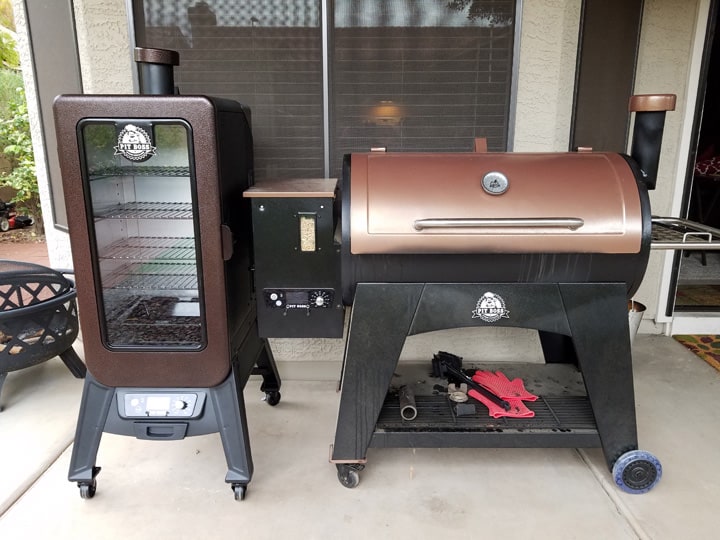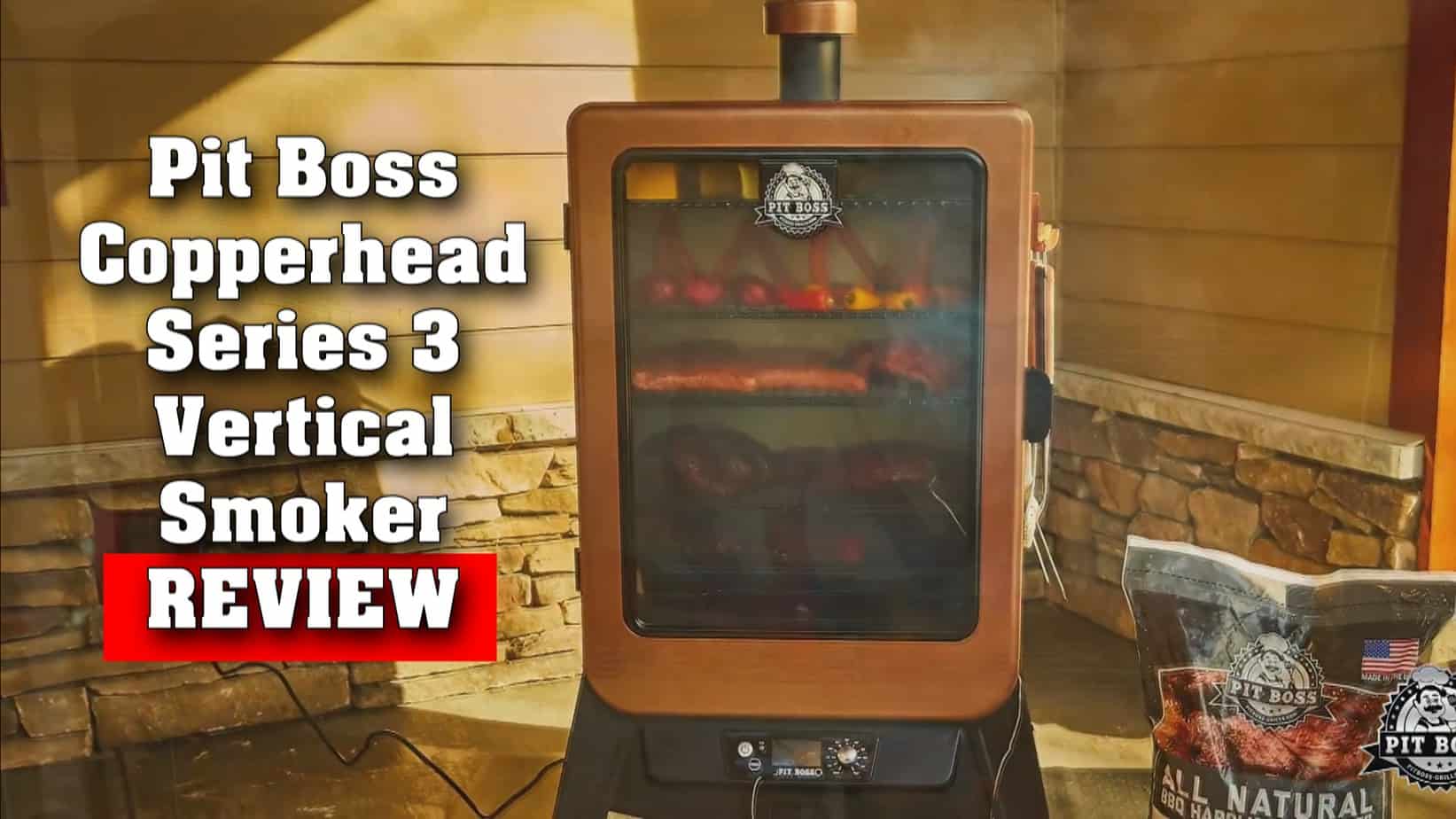Our Pit Boss Copperhead Vertical Smoker has proven itself to be an excellent smoker, even better than our pellet smoker grill which is also a Pit Boss. The video below will show you more.
The Vertical Smokers by Pit Boss are fueled by wood pellets and offer the perfect combination of convenient smoking, easy maneuvering on castor wheels, a top loading pellet hopper, and sturdy, classic good looks.
I really thought I had a great thing going with my Pit Boss Austin XL pellet smoker grill. It gives me the option to smoke, roast, grill, or slide the drip plate over for direct flame broiling. But then I got a Copperhead Vertical smoker and discovered even better smoking performance.
If you’re trying to decide between a smoker grill or a vertical smoker, ask yourself these questions: Which is more important, smoking or grilling? Do you want a great smoker or a great grill?
My Austin XL is a great grill but only a good smoker.
My Copperhead Vertical smoker is a great smoker, but can’t grill.
Both can roast and bake.
If you really want awesome smoked meats, then go Vertical. If you want versatility and great grilling performance, but only want the option to smoke occasionally, then I suggest going with a smoker grill. The Austin XL I think is the best bang for your buck with features like a glass hopper view, dual digital thermometer probes, direct flame grilling ability, and rugged good looks.
The Pit Boss 3-Series Copperhead Vertical Smoker – PBV3P1
One of the advantages of ordering one of these two-tone black and copper beauties online is home delivery. I don’t have a truck and this wouldn’t fit into either of our cars. It’s about 150 lbs all boxed up (no pellets included) and not something you want to tackle by yourself if you don’t have to.
No matter how you get it home, it will require assembly. The directions were clear and helpful, and I put mine together in about 3 hours by myself. Having an extra pair of hands would’ve been very helpful, but I got the job done anyway.
Here are the important features at a glance:
- Dimensions: 26 x 22 x 53 inches
- Inside Dimensions: 12.5 in deep / 15 in wide
- Weight without pellets: 97 lbs
- Number of Racks: 4
- 4 Castor Wheels
- Top Fill Hopper with 40 lbs pellet capacity
- Hopper has a glass view
- Power cord length: about 5 ft./ 3-prong
- Digital Thermometer 150-450 range
- Double-walled construction with blanket insulation
- Metal water pan and drip catch
I believe the Series 5 and Series 7 models are larger and have more racks, but our Series 3 model is plenty big enough for us. All the racks are adjustable and yes, you can fit a 13 lbs turkey in it!
How A Vertical Smoker Works – The Meat Smoking Process
Fortunately for guys like me, meat smoking is fairly simple. Here are the steps involved to make mouthwatering smoked meats:
1. Select well-marbled meat. I’ve discovered more than once that if you pick out the wrong meat, your meat smoking story will not have a happy ending even if you do everything else right.
2. Put your meat into brine or at least generously rub it with your seasonings of choice and let it rest overnight if you can or at least several hours.
3. Calculate your smoke start time by working backward from your serve time. For example, most of my smokes run 12 hours start to finish. I’ll also add about 30 minutes of rest time after I pull it out of the smoker. So I’ll start smoking at 5:30 am if we’re planning to eat around 6:00 pm.
4. The startup process, which takes about 5 minutes, goes like this: Check the hopper to ensure you’ve got plenty of pellets. Pull the water pan out and set it off to the side. Check the firebox to make sure it’s clean. If we’re good there, then I’ll plug the unit in and turn the temperature dial to smoke or lowest setting (it’s usually already set there). Then press the on button and leave the door open so air gets to the firebox.
5. The fan and augur will come on first followed by the heating rod getting hot enough to ignite the pellets that will start falling into the firebox.
6. After a few minutes, you’ll start to see smoke coming out of the unit, followed by the sound of fire. The smoke may get pretty intense like a campfire getting started without enough newspaper.
7. Once the heavy smoke dissipates and the sound of fire is strong, go ahead and set the dial to 250-300 and once it reaches that temperature, just let it bake a few minutes to kill any bacteria from previous uses. Fill the water pan with about 4 cups of hot water and put it into the smoker just above the heat shield.
8. Pull your meat out and prepare it to go into the smoker. If you haven’t already, spray your rack with some non-stick spray. It can mean the difference between sliding or scraping the meat off the rack later. You don’t need anything fancy. I use regular Pam. Then load your meat onto the rack of your choice. Set the temperature to your desired smoke setting and you should be good for the next however many hours you want to smoke your meat for.
9. The digital readout may indicate significant temperature fluctuations during your smoke. This is normal. Unlike electric or propane units, wood pellets don’t fall into the firebox at an exact rate. They may trickle in slowly for a bit then several may dump in all at once. The temperature will rise and fall accordingly.
Keep enough water in the water pan to keep the meat moist, but don’t forget about that water. Meaning, if you move your smoker that water is likely to splash around on the inside. It will probably go down the drip hole and into the drip pan, but it could drain into the firebox. Not good.
10. When you’re near your end time, stick your meat with a digital thermometer and make sure you’re about where you should be. It’s best not to guess. Better safe than sorry.
11. When it’s time and you’re comfortable with the temperature, pull your meat off and wrap it up in foil. Let it sit for at least 30 minutes at room temperature.
12. Turn the smoker down to smoke, leave the door open, and let the fire die out. You might take a moment to clean the wire rack with a BBQ scraper.
13. After about 5-10 minutes, press and hold the on button for about 3 seconds or until the digital screen goes dark. The fan will run for a few minutes longer before going completely quiet.
14. After the meat has rested, it’s time to serve it up. Hopefully, everything turned out well and everyone around the table is in awe of your amazing meat-smoking skills.
15. After wining and dining, your smoker should be all cooled off. Be sure to empty out any remaining water in the water pan – not down the sink! It’s probably going to be greasy. Put your smoker away until the next meat smoking adventure.
My Vertical Smoker Review: 5 Stars
I recommend everyone considering a Vertical Smoker or Pellet Smoker Grill to read the reviews, questions and answers on places like Amazon.com (get info here). Hear from other Vertical Smoker owners and make sure you’re getting the best model with the right features for your situation.

I’ve been very happy with the quality and performance of my Pit Boss smokers – both of them!

